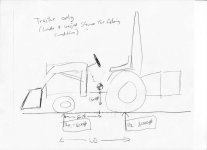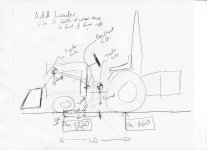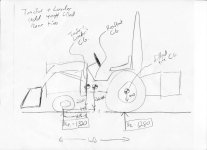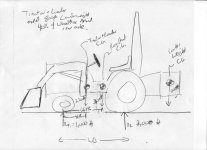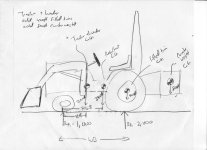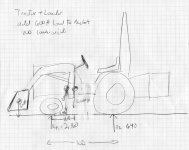hazmat
Elite Member
- Joined
- Feb 12, 2002
- Messages
- 4,051
- Location
- West Newbury, MA & Harrison, ME
- Tractor
- Kubota L5460HSTC
A discussion about this came up in the New Holland forum. I though I'd repost it here as I spent a good chunk of the evening writing it up. I know, shame on me for double posting, but I think it deserves to stand on it's own. I'm sure Dad would like to see me putting my engineering education to good use.
OK class – today we are going to learn about free body diagrams – no this isn’t *** education it is Statics – significantly more boring.
it is Statics – significantly more boring.
The discussion at hand is weather adding wheel weights or filling the rear tires will lighten the load on the front axle. The short answer is that it will not lessen the magnitude of the load on the front axle, but it will change the weight distribution between the front & rear axle.
I’ve tried to use real world numbers (from my TC18). I apologize in advance for the sloppy drawings. I’m not much of an artist. The diagrams are on flat ground – no slopes taken into account.
Your FEL manual should have information on how to ballast your tractor for safe operation - rear counterweight, wheel weights, loaded tires or a combination of 2 or more. The discusion here should show you how best to lighten the load on the front axle - steering or squishing tire problems and how not every pound of ballast is created eqaul - ballast behind the rear axle counts more.
Figure 1
Baseline tractor only
Tractor weight 1,600#
Total weight 1,600#
Dist of CG from front axle 62.5% of wheel base
Front axle load 600#
Rear axle load 1,000#
Front axle distribution 37.5%
Rear axle distribution 62.5%
Figure 2
Tractor + Loader (CG of loader is 20% of wheel base in FRONT of front axle)
Tractor weight 1,600#
Loader weight 600#
Total weight 2,200#
Dist of CG from front axle 40% of wheel base
Front axle load 1,320#
Rear axle load 880#
Front axle distribution 60%
Rear axle distribution 40%
You can see that the load on the front axle has more than doubled
Figure 3
Tractor + Loader add 400# filled Rear Tires (CG of liquid is at rear axle)
Tractor weight 1,600#
Loader weight 600#
Filled tire weight 400#
Total weight 2,600#
Dist of CG from front axle 49.3% of wheel base
Front axle load 1,320#
Rear axle load 1,280#
Front axle distribution 50.7%
Rear axle distribution 49.3%
Note that while the % of weight on the front axle has decreased from 60% to 50.7% the weight is still 1,320#
Figure 4
Tractor + Loader add 800# counter weight (CG of weight is 40% of wheel base behind rear axle)
Tractor weight 1,600#
Loader weight 600#
Counter weight 800#
Total weight 3,000 #
Dist of CG from front axle 66.7% of wheel base
Front axle load 1,000#
Rear axle load 2,000 #
Front axle distribution 33.3%
Rear axle distribution 66.7%
Both % and total weight on front axle are lower
Figure 5
Tractor + Loader add 800# counter weight and fill rear tires 400#
Tractor weight 1,600#
Loader weight 600#
Counter weight 800#
Filled tire weight 400#
Total weight 3,400 #
Dist of CG from front axle 70.6% of wheel base
Front axle load 1,000#
Rear axle load 2,400 #
Front axle distribution 29.4%
Rear axle distribution 70.6%
Further reduction in % of weight on front axle, but still the same total weight as figure 4. So why bother weighting rear tires? It reduces the chance of tipping - you have to put more weight in the bucket before it'l go over. Additionally, you gain traction and it also lowers the CG to make for more stable platform (side slopes)
Figure 6
Tractor + Loader add 600# load to bucket (CG of loadt is 40% of wheel base in front of front axle) no counterweight or filled tires
Tractor weight 1,600#
Loader weight 600#
Bucket load 600#
Total weight 2,800 #
Dist of CG from front axle 23% of wheel base
Front axle load 2,160#
Rear axle load 640 #
Front axle distribution 77%
Rear axle distribution 23%
Now we have 3.6 times the original front axle load & a whopping 77% of the weight distribution on the front axle. You can see why we need to properly ballast when using the FEL.
Class dismissed – go out and get some seat time.
OK class – today we are going to learn about free body diagrams – no this isn’t *** education
The discussion at hand is weather adding wheel weights or filling the rear tires will lighten the load on the front axle. The short answer is that it will not lessen the magnitude of the load on the front axle, but it will change the weight distribution between the front & rear axle.
I’ve tried to use real world numbers (from my TC18). I apologize in advance for the sloppy drawings. I’m not much of an artist. The diagrams are on flat ground – no slopes taken into account.
Your FEL manual should have information on how to ballast your tractor for safe operation - rear counterweight, wheel weights, loaded tires or a combination of 2 or more. The discusion here should show you how best to lighten the load on the front axle - steering or squishing tire problems and how not every pound of ballast is created eqaul - ballast behind the rear axle counts more.
Figure 1
Baseline tractor only
Tractor weight 1,600#
Total weight 1,600#
Dist of CG from front axle 62.5% of wheel base
Front axle load 600#
Rear axle load 1,000#
Front axle distribution 37.5%
Rear axle distribution 62.5%
Figure 2
Tractor + Loader (CG of loader is 20% of wheel base in FRONT of front axle)
Tractor weight 1,600#
Loader weight 600#
Total weight 2,200#
Dist of CG from front axle 40% of wheel base
Front axle load 1,320#
Rear axle load 880#
Front axle distribution 60%
Rear axle distribution 40%
You can see that the load on the front axle has more than doubled
Figure 3
Tractor + Loader add 400# filled Rear Tires (CG of liquid is at rear axle)
Tractor weight 1,600#
Loader weight 600#
Filled tire weight 400#
Total weight 2,600#
Dist of CG from front axle 49.3% of wheel base
Front axle load 1,320#
Rear axle load 1,280#
Front axle distribution 50.7%
Rear axle distribution 49.3%
Note that while the % of weight on the front axle has decreased from 60% to 50.7% the weight is still 1,320#
Figure 4
Tractor + Loader add 800# counter weight (CG of weight is 40% of wheel base behind rear axle)
Tractor weight 1,600#
Loader weight 600#
Counter weight 800#
Total weight 3,000 #
Dist of CG from front axle 66.7% of wheel base
Front axle load 1,000#
Rear axle load 2,000 #
Front axle distribution 33.3%
Rear axle distribution 66.7%
Both % and total weight on front axle are lower
Figure 5
Tractor + Loader add 800# counter weight and fill rear tires 400#
Tractor weight 1,600#
Loader weight 600#
Counter weight 800#
Filled tire weight 400#
Total weight 3,400 #
Dist of CG from front axle 70.6% of wheel base
Front axle load 1,000#
Rear axle load 2,400 #
Front axle distribution 29.4%
Rear axle distribution 70.6%
Further reduction in % of weight on front axle, but still the same total weight as figure 4. So why bother weighting rear tires? It reduces the chance of tipping - you have to put more weight in the bucket before it'l go over. Additionally, you gain traction and it also lowers the CG to make for more stable platform (side slopes)
Figure 6
Tractor + Loader add 600# load to bucket (CG of loadt is 40% of wheel base in front of front axle) no counterweight or filled tires
Tractor weight 1,600#
Loader weight 600#
Bucket load 600#
Total weight 2,800 #
Dist of CG from front axle 23% of wheel base
Front axle load 2,160#
Rear axle load 640 #
Front axle distribution 77%
Rear axle distribution 23%
Now we have 3.6 times the original front axle load & a whopping 77% of the weight distribution on the front axle. You can see why we need to properly ballast when using the FEL.
Class dismissed – go out and get some seat time.
